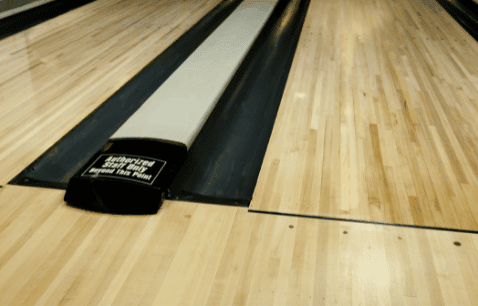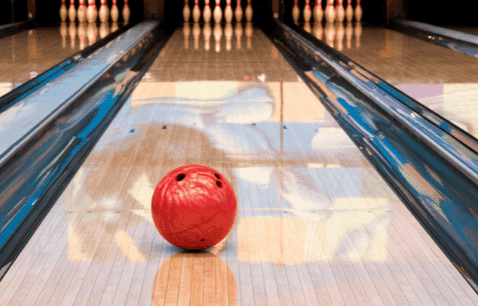Bowling lanes do not get dented easily because they are built using two types of products– wood or synthetic materials, both of which are extraordinarily strong and durable.
In addition to these materials, the lanes are also finished with layers of an oil-based solution, often polyurethane. The oil gives the bowling lane a smooth and sleek finish, while adding strength and toughness to the surface making them more dent resistant.
Bowling is a much-loved sport enjoyed by everyone of any age. Now, you’ve probably wondered how the lane stays undamaged when playing especially with heavy bowling balls. In this article, we will be looking at what goes into making the lanes strong and durable.
What Kind of Wood Are Bowling Lanes Made Of?

Bowling lanes are traditionally made from two types of wood – maple and pine. The lanes are assembled making sure that the maple and pine materials are placed in the correct areas of the lane for optimal use and durability.
Over time the wood will develop wear and tear, which are often more expensive to maintain. So, some lanes are now made from synthetic materials that look more visually modern but are tougher and take less effort and money to maintain.
Maple ; Pine
Maple is used for the area closer to the pin deck and the first twelve feet of the lane, whilst pine is used in the middle areas of the lane.
Maple is used at the front and back of the lanes because it is tougher and can handle the impact of the ball, even when thrown hard. It is shock-resistant factor making it perfect for bowling. It is also better for handling the constant sanding and finishing during maintenance.
The middle part of the lane is usually pine because it is softer but strong enough for a bowling ball. It gives the ball better movement and interaction with the surface as it moves down towards the pins. Pine is also resistant to shrinking and decay.
How They Work Together
The average bowling lane measures at 60ft by 42 inches, which is a combination of pine and maple.
The ratio is divided into the following combination: maple at 22ft and pine making up 41ft. The lane is also often laminated at around two inches of thickness, which makes them even stronger.
Walnut
Walnut can also be used for bowling lanes, and are often placed as markers because the chocolate coloring of the wood offers a contrast to the amber tones of the pine and maple material.
Synthetic
Most lanes are now made from synthetic materials which are manufactured to have a wood-like appearance but are often tougher and harder. They are made from reinforced composite materials that make them durable. The material requires less maintenance and oil because it is also a smoother surface for balls to glide on. Lanes made from synthetic material use less oil and demand less maintenance, which makes them more affordable to have in place.
Synthetic surfaces are tougher in comparison to wood, and so the manufacturing process of the bowling balls had to also adapt to compliment the surface, so gameplay is not comprised.
Oil-Based Treatments
After the lane is put together the wood is then coated with an oil-based substance, like polyurethane, to finish and protect the surface of the lane. It is perfect for adding strength and shine to the surface. The finish ensures that the wood has protection from the impact of the ball and reduces issues of dents.
How Are Bowling Lanes so Durable?
Bowling lanes use strong materials that can withstand the impact of the ball. These lanes also require maintenance and treatment to lessen the damage over time. After the lane has been laid down it is coated with oil or conditioner, which is often made from polyurethane, to finish the wood, and make sure it is strong and tough.
Most lane conditioners used today are sourced from mineral-type oils and include additives that help modify friction and lubricate the surface. These are all necessary for lane maintenance and to reduce the dents caused by the balls.
The conditioners maintain the durability of the lane. It also ensures that the ball glides along smoothly, which improves the overall performance and prevent damages to the lane.
Synthetic Lanes
Many bowling lanes are now created from synthetic materials that look like wood. These materials are often hardier and tougher than the classic maple and pine lanes.
The synthetic lanes also require less maintenance and oil. This is because it is already a smoother surface for the bowling balls to travel on. Finally, these lanes made out of synthetic material are also more affordable due to the lower cost of maintenance.
What Is the Purpose of Lane Oil?
There are a few different purposes for the coating of oil placed on all bowling lanes. The oil adds strength and shine, ensuring further protection of the bowling lane.
However, oil on the lane also affects the player’s game and has become an essential part of professional bowling. When thrown, bowling balls will pick oil up on their surface. This changes the oil pattern on the lane and can make previously dry areas wet. The oil carried by the ball is called ‘carry-down’. It can have a large impact on the bowling game.
Bowling alleys use many different patterns of oil in professional games. These oil patterns change the way the game is played, forcing the players to adapt their playstyle.
Specialized machinery is used to coat the lane with the oil pattern of the alley’s choosing. Oil applied to the bowling lane based on volume, lane shape, and length.
Many places refer to the basic oil pattern used as the “house” pattern. Although the exact specifics of this pattern depend on the location, they are all similar The house pattern has more oil in the middle of the bowling lane while the outside edges have less. The oil traditionally stops forty feet from the foul line.
The house pattern is for amateur bowlers. It ensures that patrons of the bowling alley are enjoying themselves.
Oil’s Affects on the Bowling Ball
Where the bowling ball exits, the oil pattern is called the breakpoint. Finding the breakpoint is key to gaining a good score in bowling.
In order to find the breakpoint, something called the rule of 31 must be used. This means you subtract 31 from the oil pattern’s length. This will give you where the ball exits. Professionals use this to their advantage in order to maximize their scores.
Did you know that most professional bowlers wipe down their bowling balls after each shot? Oil track is excess oil that is left on a bowling ball after a shot. When a lane is oiled too much, the amount of oil tracked on your bowling ball will greatly affect the way it rolls. Using a bowling ball wipe pad like this one after each shot can help keep excessive oil off of your bowling ball.
How Does It All Work?
The viscosity of the fluid can determine the friction of the fluid internally. A high friction rate will need more force to move the ball. So, the higher the viscosity of the fluid means more force is needed to move the ball in comparison to fluids with less viscosity.
Conditioners and oil that have a high viscosity rate can cause resistance to the ball and cause them to move slower and sometimes hook earlier. In this case, the lower viscosity rate produces a slicker surface than high viscosity, but the latter is more durable when used. However, the lower viscosity products allow for smoother and more effective carry down the lane.
Magic Oil – Protect the Surface and Enhance Strategy

The use of oils and conditioners on lanes gradually transformed from maintenance to strategical use. It can enhance the performance and movement of the ball down the lane. The barrier between the bowling ball and the surface, not only offers protection from dents but also manipulates the movement of the ball.
The oil used on lanes often includes additives that can lower the amount of oil carried down during play. The additives also prevent any changes to the movement of the ball down the lane.
Can a Bowling Ball Break the Lane?
It is possible to break a lane, with consistent use and time. Sometimes, even rolling the ball can make minor dents to a lane, but this occurs more on wooden lanes.
If the lane is built with durable materials and maintained with conditioners and oil, then this should slow down wear and prevent the lane from breaking upon contact with a ball. However, newer synthetic lanes made from a combination of plastics are often harder and more durable in comparison to wooden lanes.
It is common practice to coat the lane with oil to maintain and protect the surface, which means less damage is caused. Wooden lanes are also re-surfaced every couple of years to fix any uneven textures.
Final Thoughts
A bowling lane that is made well can stand the test of time, it can withstand the stresses of a heavy bowling ball and reduce dents. Therefore, it is important to build a lane with durability in mind.
Over time, the use of synthetic materials could be more valuable over the traditional wooden components, as it is easier to maintain and are often tougher and more durable, while some of the newest options are more environmentally friendly as well. Using synthetic materials could also mean fewer issues with dents and damages, limiting the spending on maintenance and repairs.
However, both materials are strong enough to withstand the weight and impact of a bowling ball and prevent overall damage to the surface. Oil treatments and conditioners play a major factor in keeping the surface durable and so the bowling ball causes fewer dents, and the lifespan of the lane is greatly improved.


